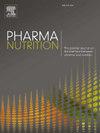橙皮苷作为结直肠癌的潜在治疗剂:通过网络药理学引导策略靶向细胞系中的PI3K/AKT和EMT
IF 2.4
Q3 NUTRITION & DIETETICS
引用次数: 0
摘要
橙皮素是一种天然存在的类黄酮化合物,大量存在于柑橘类水果果皮和传统中药中。它具有多种药理特性,是一种很有前途的抗癌多靶点候选药物。本研究通过网络药理学、分子对接和实验验证相结合,系统探讨橙皮苷抗结直肠癌(CRC)作用的分子机制。网络药理学分析鉴定出42个橙皮素在结直肠癌中的核心靶点,分子对接证实了较强的结合亲和力(结合能<;−7 kcal/mol),包括表皮生长因子受体(EGFR)、苏氨酸激酶1 (AKT1)、原癌基因酪氨酸蛋白激酶Src (Src)、磷脂酰肌醇-4,5-二磷酸3-激酶催化亚基α (PIK3CA)和基质金属蛋白酶-9 (MMP9)。体外实验表明橙皮苷能剂量依赖性地抑制HCT116和Lovo细胞的增殖、迁移和侵袭。在机制上,橙皮素通过上调E-cadherin和下调N-cadherin、Vimentin和Snail蛋白和mRNA水平逆转上皮-间质转化(EMT)。Western blot分析显示,橙皮素通过降低PI3K (Tyr458)和AKT (Ser473)的磷酸化来抑制PI3K/AKT通路的激活。临床数据进一步验证了这些靶点的治疗相关性,表明EGFR、AKT1、PIK3CA和MMP9的高表达与CRC患者的不良预后相关。综上所述,这些研究结果表明橙皮苷是一种很有前景的多靶点营养补充剂,可用于治疗结直肠癌,并显示PI3K/AKT信号通路和EMT进展的双重调节。本文章由计算机程序翻译,如有差异,请以英文原文为准。
Hesperetin as a potential therapeutic agent for colorectal cancer: Targeting PI3K/AKT and EMT in cell lines through network pharmacology-guided strategies
Hesperetin is a naturally occurring flavonoid compound abundantly present in citrus fruit peels and Traditional Chinese Medicinal (TCM). It exhibits diverse pharmacological properties and represents a promising multi-target candidate for anticancer therapy. This study systematically investigated the molecular mechanisms underlying the anti-colorectal cancer (CRC) effects of hesperetin by integrating network pharmacology, molecular docking, and experimental validation. Network pharmacology analysis identified 42 core targets of hesperetin in CRC, with molecular docking confirming strong binding affinities (binding energy < −7 kcal/mol) between hesperetin and key proteins, including Epidermal Growth Factor Receptor (EGFR), Threonine Kinase 1 (AKT1), Proto-oncogene Tyrosine-protein Kinase Src (SRC), Phosphatidylinositol-4,5-Bisphosphate 3-Kinase Catalytic Subunit Alpha (PIK3CA), and Matrix Metalloproteinase-9 (MMP9). In vitro experiments demonstrated that hesperetin dose-dependently inhibited the proliferation, migration, and invasion of HCT116 and Lovo cells. Mechanistically, hesperetin reversed epithelial-mesenchymal transition (EMT) by upregulating E-cadherin and downregulating N-cadherin, Vimentin, and Snail at both protein and mRNA levels. Western blot analysis revealed that hesperetin suppressed PI3K/AKT pathway activation by reducing phosphorylation of PI3K (Tyr458) and AKT (Ser473). Clinical data further validated the therapeutic relevance of these targets, showing that high expression of EGFR, AKT1, PIK3CA, and MMP9 correlated with poor prognosis in CRC patients. Collectively, these findings establish hesperetin as a promising multi-target nutritional supplement agent against CRC, demonstrating dual modulation of both PI3K/AKT signaling and EMT progression.
求助全文
通过发布文献求助,成功后即可免费获取论文全文。
去求助
来源期刊

PharmaNutrition
Agricultural and Biological Sciences-Food Science
CiteScore
5.70
自引率
3.10%
发文量
33
审稿时长
12 days
 求助内容:
求助内容: 应助结果提醒方式:
应助结果提醒方式:


